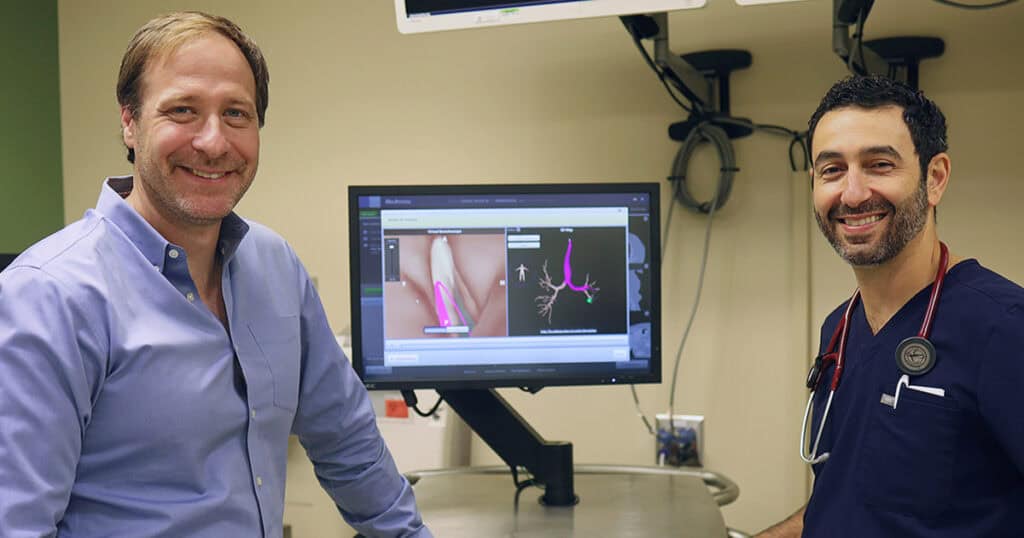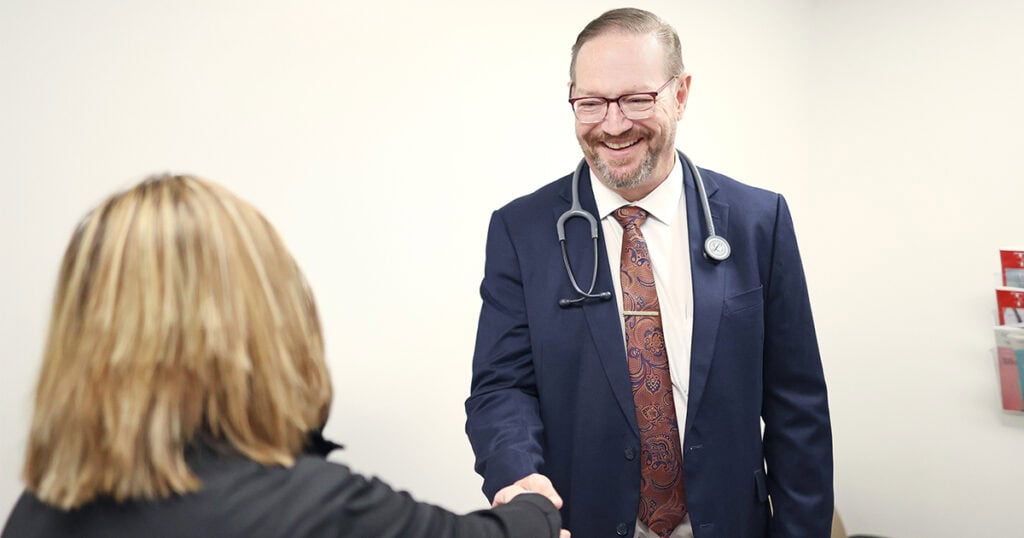Understanding Achilles Injuries and Effective Care Strategies with Dr. Geoff Watson
Published: April 1, 2024
Originally published in the Williamson Herald —
Flowers are blooming, birds are chirping and the great outdoors are waiting! If your April forecast calls for a return to spring sports or getting back into a running routine, the foot and ankle specialists at Bone and Joint Institute of Tennessee are committed to providing quality orthopaedic care to keep you on your toes and active this spring.
Geoff Watson, M.D., an orthopaedic surgeon at Bone and Joint Institute, knows firsthand how important it can be to receive the right foot and ankle care when staying active. Years ago, Watson’s father was diagnosed with a sprained ankle that was later found to be an Achilles tendon tear – it was six weeks before doctors corrected the mistake and performed surgery.
“Watching my father deal with the challenges of that misdiagnosis inspired me to specialize in foot and ankle orthopaedics, so that I could ensure my patients have a much better experience,” said Dr Watson.
Even though staying consistently active is beneficial for overall health, Achilles tendon injuries are an important risk factor to be aware of. Achilles tendonitis is a condition caused by overuse of the tendon. Often, this can affect long-distance runners as they get back into their routine after taking the winter months off. The overuse results in inflammation either at the back of the heel, where the tendon attaches to the bone, or just below the ankle joint, causing discomfort and swelling.
“In these cases, the more you use it, the more the tendonitis can flare up,” said Dr. Watson. “The good news is that 75-80% of the time, it can be rehabilitated without the need for surgery.”
In addition to rehab, Dr. Watson often uses a treatment method involving platelet-rich plasma (PRP) found in the patient’s own blood. Taking the body’s natural anti-inflammatory and injecting it back into the tendon can aid in the recovery process and often help patients avoid surgery.
Even if you’re not an avid long-distance runner, you can still be at risk for Achilles tendon injuries. Achilles tendon tears are often caused by a quick burst of activity such as a pivot or jump in sports like basketball, tennis and pickleball. Dr. Watson says Achilles tear patients often describe the injury as feeling like someone hit the back of your leg but looking back to find no one there.
“Achilles tears are missed about 25% of the time because the patient believes they have a sprained ankle or a similar minor injury,” said Watson. “Even with a tear, you may still have mobility in that joint because there are other tendons that allow the foot to move.”
When you experience this type of injury, it’s always beneficial to get evaluated as soon as possible. If the patient is seen within two to four days of the initial injury, it’s possible to treat an Achilles tear non-surgically. Waiting more than one day for evaluation can increase your risk of rupturing the tendon again.
“The younger and more active a patient is, the more likely I am to recommend surgery to repair a tear,” says Dr. Watson. “Surgery decreases the risk of reinjury and gets you back to enjoying the activities you love.”
During surgery, Dr. Watson utilizes a percutaneous Achilles repair system (PARS) that enables him to see and repair the tear using a small one-inch incision. This innovative technology reduces risk of infection, minimizes scarring and creates a better overall cosmetic appearance.
Recovery from Achilles tendonitis and Achilles tears are similar. Patients usually spend six to eight weeks in a form of protection such as a splint of boot. In addition, the patient will require a few months of physical therapy and can expect a full recovery within a year.
To avoid injury, Dr. Watson recommends replacing your running shoes once every six months and reducing treadmill usage as the impact can be hard on foot and ankle joints.
“The most important thing you can do to protect your Achilles tendon is to be consistent with your sport. These injuries often happen to weekend warriors, or those who pick up a new sport without the proper conditioning,” said Dr. Watson. “Stretching is also crucial to staying active. I suggest building in a routine of stretching twice a day so that it becomes a habit much like brushing your teeth.”
However, if you do experience a foot or ankle injury that results in lingering pain or an inability to bear weight, Dr. Watson encourages you to schedule an evaluation with the experienced providers at Bone and Joint Institute of Tennessee.
To learn more visit, https://BoneAndJointTN.org.
Understanding Achilles Injuries and Effective Care Strategies with Dr. Geoff Watson
Originally published in the Williamson Herald —
Flowers are blooming, birds are chirping and the great outdoors are waiting! If your April forecast calls for a return to spring sports or getting back into a running routine, the foot and ankle specialists at Bone and Joint Institute of Tennessee are committed to providing quality orthopaedic care to keep you on your toes and active this spring.
Geoff Watson, M.D., an orthopaedic surgeon at Bone and Joint Institute, knows firsthand how important it can be to receive the right foot and ankle care when staying active. Years ago, Watson’s father was diagnosed with a sprained ankle that was later found to be an Achilles tendon tear – it was six weeks before doctors corrected the mistake and performed surgery.
“Watching my father deal with the challenges of that misdiagnosis inspired me to specialize in foot and ankle orthopaedics, so that I could ensure my patients have a much better experience,” said Dr Watson.
Even though staying consistently active is beneficial for overall health, Achilles tendon injuries are an important risk factor to be aware of. Achilles tendonitis is a condition caused by overuse of the tendon. Often, this can affect long-distance runners as they get back into their routine after taking the winter months off. The overuse results in inflammation either at the back of the heel, where the tendon attaches to the bone, or just below the ankle joint, causing discomfort and swelling.
“In these cases, the more you use it, the more the tendonitis can flare up,” said Dr. Watson. “The good news is that 75-80% of the time, it can be rehabilitated without the need for surgery.”
In addition to rehab, Dr. Watson often uses a treatment method involving platelet-rich plasma (PRP) found in the patient’s own blood. Taking the body’s natural anti-inflammatory and injecting it back into the tendon can aid in the recovery process and often help patients avoid surgery.
Even if you’re not an avid long-distance runner, you can still be at risk for Achilles tendon injuries. Achilles tendon tears are often caused by a quick burst of activity such as a pivot or jump in sports like basketball, tennis and pickleball. Dr. Watson says Achilles tear patients often describe the injury as feeling like someone hit the back of your leg but looking back to find no one there.
“Achilles tears are missed about 25% of the time because the patient believes they have a sprained ankle or a similar minor injury,” said Watson. “Even with a tear, you may still have mobility in that joint because there are other tendons that allow the foot to move.”
When you experience this type of injury, it’s always beneficial to get evaluated as soon as possible. If the patient is seen within two to four days of the initial injury, it’s possible to treat an Achilles tear non-surgically. Waiting more than one day for evaluation can increase your risk of rupturing the tendon again.
“The younger and more active a patient is, the more likely I am to recommend surgery to repair a tear,” says Dr. Watson. “Surgery decreases the risk of reinjury and gets you back to enjoying the activities you love.”
During surgery, Dr. Watson utilizes a percutaneous Achilles repair system (PARS) that enables him to see and repair the tear using a small one-inch incision. This innovative technology reduces risk of infection, minimizes scarring and creates a better overall cosmetic appearance.
Recovery from Achilles tendonitis and Achilles tears are similar. Patients usually spend six to eight weeks in a form of protection such as a splint of boot. In addition, the patient will require a few months of physical therapy and can expect a full recovery within a year.
To avoid injury, Dr. Watson recommends replacing your running shoes once every six months and reducing treadmill usage as the impact can be hard on foot and ankle joints.
“The most important thing you can do to protect your Achilles tendon is to be consistent with your sport. These injuries often happen to weekend warriors, or those who pick up a new sport without the proper conditioning,” said Dr. Watson. “Stretching is also crucial to staying active. I suggest building in a routine of stretching twice a day so that it becomes a habit much like brushing your teeth.”
However, if you do experience a foot or ankle injury that results in lingering pain or an inability to bear weight, Dr. Watson encourages you to schedule an evaluation with the experienced providers at Bone and Joint Institute of Tennessee.
To learn more visit, https://BoneAndJointTN.org.
Published: April 1, 2024










